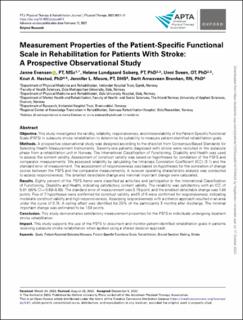| dc.description.abstract | Objective This study investigated the validity, reliability, responsiveness, and interpretability of the Patient-Specific Functional Scale (PSFS) in subacute stroke rehabilitation to determine its suitability to measure patient-identified rehabilitation goals. Methods A prospective observational study was designed according to the checklist from Consensus-Based Standards for Selecting Health Measurement Instruments. Seventy-one patients diagnosed with stroke were recruited in the subacute phase from a rehabilitation unit in Norway. The International Classification of Functioning, Disability and Health was used to assess the content validity. Assessment of construct validity was based on hypotheses for correlation of the PSFS and comparator measurements. We assessed reliability by calculating the Intraclass Correlation Coefficient (ICC) (3.1) and the standard error of measurement. The assessment of responsiveness was based on hypotheses for the correlation of change scores between the PSFS and the comparator measurements. A receiver operating characteristic analysis was conducted to assess responsiveness. The smallest detectable change and minimal important change were calculated. Results Eighty percent of the PSFS items were classified as activities and participation in the International Classification of Functioning, Disability and Health, indicating satisfactory content validity. The reliability was satisfactory with an ICC of 0.81 (95% CI = 0.69–0.89). The standard error of measurement was 0.70 point, and the smallest detectable change was 1.94 points. Five of 7 hypotheses were confirmed for construct validity, and 5 of 6 were confirmed for responsiveness, indicating moderate construct validity and high responsiveness. Assessing responsiveness with a criterion approach resulted in an area under the curve of 0.74. A ceiling effect was identified for 25% of the participants 3 months after discharge. The minimal important change was estimated to be 1.58 points. Conclusion This study demonstrates satisfactory measurement properties for the PSFS in individuals undergoing inpatient stroke rehabilitation. Impact This study supports the use of the PSFS to document and monitor patient-identified rehabilitation goals in patients receiving subacute stroke rehabilitation when applied using a shared decision approach. Goals, Patient-Reported Outcome Measure, Patient-Specific Functional Scale, Rehabilitation, Shared Decision Making, Stroke | en_US |

